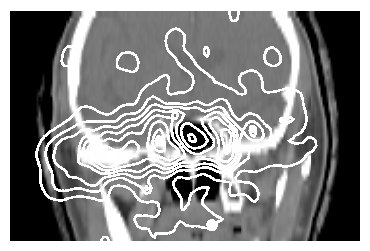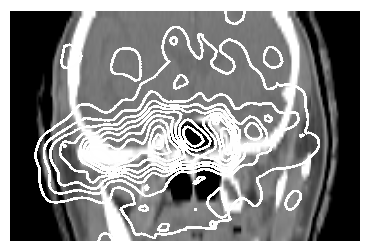|
Over the last 3 years in-beam PET has proven its capability of quality assurance in carbon ion
tumour therapy at the pilot project of cancer therapy at the Gesellschaft für
Schwerionenforschung (GSI) in Darmstadt, Germany [1].
It is planned to integrate a new positron camera into the proposed dedicated
hospital-based facility for ion beam therapy in Heidelberg, Germany [2].
We have investigated the possibility of using LSO as the scintillation material
for the next generation of in-beam PET cameras.
We address the issue of background coincidences arising from the natural radioactivity of LSO.
Natural lutetium contains the radioactive isotope 176Lu
with an abundance of 2.59 %, causing a background activity of 280 Bq per cm3 of LSO.
176Lu undergoes b--decay feeding excited levels of 176Hf at 597 keV
and 998 keV with probabilities of 99.66 % and 0.34 %, respectively.
These levels are de-excited via a prompt g-ray cascade of 307, 202 and 88 keV,
which is topped by a 401 keV transition in the case of the 998 keV level.
This results in undesired true coincidences
when the electron and low-energy g-rays deposit enough energy in the crystal,
where the b--decay takes place, and the g-rays of higher energy escape
and deposit their energy in an opposite crystal.
Because the true count rate measured with the BGO-based dual-head positron camera BASTEI
during the cancer treatment averages at only 100 coincidences/s we studied the
influence of the LSO background on realistic in-beam PET images.
Therefore, we have estimated the background coincidences expected for the detector
geometry of BASTEI assuming LSO as detector material. The estimation takes into
account the energy distribution of the electron resulting from the b--decay,
together with all g-ray combinations that lead to a background coincidence.
This has been done for energy windows of 250 - 850 keV, 350 - 650 keV and 400 - 600 keV,
two g-ray combinations
that are possible within the energy windows and an energy resolution of 15 % FWHM.
Furthermore, the attenuation of the escaping 307 or 401 keV g-rays due to the
presence of the patient has been taken into account.
The analysis [3] shows that the major component of the background of true
coincidences caused by 176Lu
originates from the escape of the 307 keV g-ray and subsequent detection by
another detector of the positron camera. If, however, an energy window between
350 - 650 keV or narrower is applied these background coincidences are effectively
rejected and an influence on the reconstructed b+-activity distribution
can be avoided (Fig. 1).
Fig. 1
The left Figure shows a typical b+-activity distribution as it
was measured by the BGO-based positron camera BASTEI. The image on the right shows the same
measured b+-activity distribution but with background coincidences added to the
original PET scan as they would be expected for an LSO-based BASTEI assuming
an energy window of 350 - 650 keV.
1 Gesellschaft für Schwerionenforschung Darmstadt
References
[1] W. Enghardt et al, Nucl. Physics A 654 (1999) 1047c
[2] K.D. Gross, M. Pavlovic (eds.), Proposal for a dedicated ion beam
facility for cancer therapy, 1998
[3] K. Lauckner et al, An LSO-based scanner for in-beam PET:
A feasibility study, IEEE NSS/MIC Conf. Rec., 2000
|
IKH
06/26/01
© K. Lauckner
|
|

